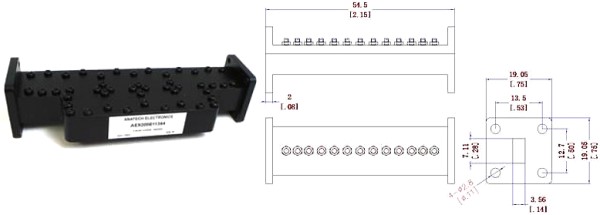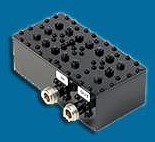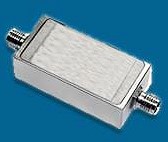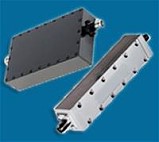|

 Sam Benzacar of
Anatech
Electronics, an RF and microwave filter company, has published his February
2022 newsletter that features his short op-ed entitled "Wi-Fi HaLow Takes Aim at
Long-Range IoT," where he points out a serious limitation to the evolving mm-wave
craze that is synonymous with 5G and 6G (a major component of IoT). The super wide
bandwidths available with mm-wave are great, but the familiar
Friis equation governing
free space path loss shows that power at the receiver (PRx) decreases
at a rate of 20 dB per decade as frequency increases. Wi-Fi HaLow operates
in the sub-1 GHz realm, so it naturally (literally) has a longer range than
even the 2.4 and 5 GHz ISM band WiFi systems. Also included in this newsletter
are a few stories on industry happenings like the FCC mandating specific specification
labels for WiFi products and mm-wave shoe screening at airports (underwear screening
comes next). Sam Benzacar of
Anatech
Electronics, an RF and microwave filter company, has published his February
2022 newsletter that features his short op-ed entitled "Wi-Fi HaLow Takes Aim at
Long-Range IoT," where he points out a serious limitation to the evolving mm-wave
craze that is synonymous with 5G and 6G (a major component of IoT). The super wide
bandwidths available with mm-wave are great, but the familiar
Friis equation governing
free space path loss shows that power at the receiver (PRx) decreases
at a rate of 20 dB per decade as frequency increases. Wi-Fi HaLow operates
in the sub-1 GHz realm, so it naturally (literally) has a longer range than
even the 2.4 and 5 GHz ISM band WiFi systems. Also included in this newsletter
are a few stories on industry happenings like the FCC mandating specific specification
labels for WiFi products and mm-wave shoe screening at airports (underwear screening
comes next).
A Word from Sam Benzacar
Wi-Fi HaLow Takes Aim at Long-Range IoT
 By Sam Benzacar By Sam Benzacar
The proliferation of Wi-Fi standards continues with IEEE 802.11ah (Wi-Fi HaLow)
standard certified last November by the Wi-Fi Alliance, and unlike all but one other
Wi-Fi standard, this one operates in spectrum below 1 GHz. That makes it nicely
suited for IoT and a variety of other applications that previous variants cannot
serve because of their limited range. In contrast, Wi-Fi HaLow can cover distances
of at least 1 km, can penetrate through walls and other obstacles, and consumes
about the same amount of DC power as Bluetooth. Its maximum data rate is 347 Mb/s,
which is more than adequate for nearly every industrial IoT device.
For anyone following Wi-Fi, it's easy to confuse Wi-Fi HaLow with IEEE 802.11af
(White-Fi, Super Wi-Fi) that was developed earlier and operates on a licensed basis
in the VHF and UHF spectrum between 54 and 790 MHz uses cognitive radio technology.
It's cognitive because it uses a level of intelligence to mitigate interference
between various nearby services such as analog and digital TV and wireless microphones.
Wi-Fi Halo was designed specifically for the use with sensors and operates in traditional
unlicensed Industrial Scientific and Medical (ISM) bands. It offers a sleep mode
to conserve battery charge, and short data packets minimize transmit time and power
usage.
 Another big benefit for IoT is that it can support up to 8191 nodes, and an antenna-sectorization
feature partitions the coverage area so stations can pass messages over longer distances
at low power. It has native IP support as well as the latest levels of Wi-Fi security
and as an open standard doesn't need proprietary hubs or gateways. The standard
is also backward compatible with older Wi-Fi protocols. Another big benefit for IoT is that it can support up to 8191 nodes, and an antenna-sectorization
feature partitions the coverage area so stations can pass messages over longer distances
at low power. It has native IP support as well as the latest levels of Wi-Fi security
and as an open standard doesn't need proprietary hubs or gateways. The standard
is also backward compatible with older Wi-Fi protocols.
What all this means is that there is finally a Wi-Fi standard that can accommodate
an enormous number of applications and sensor nodes via a single access point over
long distances, and as the devices it communicates with can operate at very low
power, they can optimize the operating lifetime of a coin cell battery. Realistically,
its only drawback at the moment is its comparatively low data transfer rates compared
with the current Wi-Fi 6 and eventually Wi-Fi 7, but the Wi-Fi Alliance is working
to increase them over time. When that occurs, it might just be the only Wi-Fi standard
that matters.
We can always find a solution!
Sigfox Down but Not Out
 The French low-power
wide area network (LPWAN) company Sigfox has filed for receivership due to what
the company calls slower than expected adoption worsened by the pandemic. The company
has been in turmoil for many years as executives have come and gone and financial
targets have been missed. According to French law, because it can continue to operate
for six months while it figures out how to either restructure itself or be sold.
At the moment, Sigfox reportedly supports only 20 million connections worldwide,
a tiny share of a market in which 2.1 billion IoT connections are already in operation. The French low-power
wide area network (LPWAN) company Sigfox has filed for receivership due to what
the company calls slower than expected adoption worsened by the pandemic. The company
has been in turmoil for many years as executives have come and gone and financial
targets have been missed. According to French law, because it can continue to operate
for six months while it figures out how to either restructure itself or be sold.
At the moment, Sigfox reportedly supports only 20 million connections worldwide,
a tiny share of a market in which 2.1 billion IoT connections are already in operation.
 FCC Mandates Nutrition
Labels for Broadband FCC Mandates Nutrition
Labels for Broadband
The broadband and cable business has long been criticized for many of its policies,
perhaps the most onerous of which is trying to understand the monthly bill. To solve
this, the FCC has come up with what the media is calling "nutrition labels". It
would require carriers such as AT&T, Comcast, and Verizon two provide labels
similar to those found on food products at the point of sale. They will include
the price of the plan, its speed, data allowances, any introductory rates that might
lead to later price hikes, and practices such as data throttling.
FirstNet Deployments Surge
 FirstNet added more than
1 million connections in 2021, adding 3 million connections to more than 19,500
public-safety agencies, according to a report from AT&T that is responsible
for building and maintaining the nationwide public-safety broadband network. The
uptake is due in part because the FirstNet market has grown to include not just
state and local fire, police, and EMS, the "primary" but federal users such as military
personnel and 911 telecommunicators. FirstNet also serves "extended primary" users
that often support emergency responders, such as workers in the healthcare, utility.
and government sectors. In October, AT&T announced that it has completed more
than 95% of the contracted Band 14 deployment for the FirstNet system, surpassing
the milestone about 6 months ahead of schedule. FirstNet added more than
1 million connections in 2021, adding 3 million connections to more than 19,500
public-safety agencies, according to a report from AT&T that is responsible
for building and maintaining the nationwide public-safety broadband network. The
uptake is due in part because the FirstNet market has grown to include not just
state and local fire, police, and EMS, the "primary" but federal users such as military
personnel and 911 telecommunicators. FirstNet also serves "extended primary" users
that often support emergency responders, such as workers in the healthcare, utility.
and government sectors. In October, AT&T announced that it has completed more
than 95% of the contracted Band 14 deployment for the FirstNet system, surpassing
the milestone about 6 months ahead of schedule.
Millimeter-Wave Shoe Screening for Airports
 Liberty Defense
Holdings's Hexwave millimeter-wave shoe screening technology that was initially
developed at Pacific Northwest National Laboratory (PNNL) has been awarded the 2022
Interagency Partnership Award from the Federal Laboratory Consortium for Technology
Transfer (FLC). The technology, when combined with a high-definition advanced body
scanner that the company is also licensed for, can potentially eliminate the need
for passengers to remove their shoes during the check-in process. It can detect
objects in footwear that should reduce the time and annoyance of the screening process.
Hexwave can be integrated into the floor of existing airport body scanning portals
or be used as a standalone unit. Liberty Defense
Holdings's Hexwave millimeter-wave shoe screening technology that was initially
developed at Pacific Northwest National Laboratory (PNNL) has been awarded the 2022
Interagency Partnership Award from the Federal Laboratory Consortium for Technology
Transfer (FLC). The technology, when combined with a high-definition advanced body
scanner that the company is also licensed for, can potentially eliminate the need
for passengers to remove their shoes during the check-in process. It can detect
objects in footwear that should reduce the time and annoyance of the screening process.
Hexwave can be integrated into the floor of existing airport body scanning portals
or be used as a standalone unit.
Getting Ready for 5G:
Anatech Electronics introduce New Ka band 30.5 GHz Waveguide Band Pass Filter.
Featuring a center frequency of 30.5 GHz, a bandwidth of 1000 MHz, an Insertion
Loss 1 dB Max, and a Power Handling is 20 watts.

Anatech Electronics Introduces a New Line of Suspended Stripline and
Waveguide Type RF Filters
Check out Our Filter Products



Cavity Band Pass Filters
LC Band Pass Filters Cavity Bandstop/Notch Filter
About Anatech Electronics
Anatech Electronics, Inc. (AEI) specializes in the design and manufacture of
standard and custom RF and microwave filters and other passive components and subsystems
employed in commercial, industrial, and aerospace and applications. Products are
available from an operating frequency range of 10 kHz to 30 GHz and include cavity,
ceramic, crystal, LC, and surface acoustic wave (SAW), as well as power combiners/dividers,
duplexers and diplexers, directional couplers, terminations, attenuators, circulators,
EMI filters, and lightning arrestors. The company's custom products and capabilities
are available at www.anatechelectronics.com.
Contact:
Anatech Electronics, Inc.
70 Outwater Lane
Garfield, NJ 07026
(973) 772-4242
sales@anatechelectronics.com
Posted February 20, 2022
|





























 By Sam Benzacar
By Sam Benzacar
 The French low-power
wide area network (LPWAN) company Sigfox has filed for receivership due to what
the company calls slower than expected adoption worsened by the pandemic. The company
has been in turmoil for many years as executives have come and gone and financial
targets have been missed. According to French law, because it can continue to operate
for six months while it figures out how to either restructure itself or be sold.
At the moment, Sigfox reportedly supports only 20 million connections worldwide,
a tiny share of a market in which 2.1 billion IoT connections are already in operation.
The French low-power
wide area network (LPWAN) company Sigfox has filed for receivership due to what
the company calls slower than expected adoption worsened by the pandemic. The company
has been in turmoil for many years as executives have come and gone and financial
targets have been missed. According to French law, because it can continue to operate
for six months while it figures out how to either restructure itself or be sold.
At the moment, Sigfox reportedly supports only 20 million connections worldwide,
a tiny share of a market in which 2.1 billion IoT connections are already in operation.

 FirstNet added more than
1 million connections in 2021, adding 3 million connections to more than 19,500
public-safety agencies, according to a report from AT&T that is responsible
for building and maintaining the nationwide public-safety broadband network. The
uptake is due in part because the FirstNet market has grown to include not just
state and local fire, police, and EMS, the "primary" but federal users such as military
personnel and 911 telecommunicators. FirstNet also serves "extended primary" users
that often support emergency responders, such as workers in the healthcare, utility.
and government sectors. In October, AT&T announced that it has completed more
than 95% of the contracted Band 14 deployment for the FirstNet system, surpassing
the milestone about 6 months ahead of schedule.
FirstNet added more than
1 million connections in 2021, adding 3 million connections to more than 19,500
public-safety agencies, according to a report from AT&T that is responsible
for building and maintaining the nationwide public-safety broadband network. The
uptake is due in part because the FirstNet market has grown to include not just
state and local fire, police, and EMS, the "primary" but federal users such as military
personnel and 911 telecommunicators. FirstNet also serves "extended primary" users
that often support emergency responders, such as workers in the healthcare, utility.
and government sectors. In October, AT&T announced that it has completed more
than 95% of the contracted Band 14 deployment for the FirstNet system, surpassing
the milestone about 6 months ahead of schedule.  Liberty Defense
Holdings's Hexwave millimeter-wave shoe screening technology that was initially
developed at Pacific Northwest National Laboratory (PNNL) has been awarded the 2022
Interagency Partnership Award from the Federal Laboratory Consortium for Technology
Transfer (FLC). The technology, when combined with a high-definition advanced body
scanner that the company is also licensed for, can potentially eliminate the need
for passengers to remove their shoes during the check-in process. It can detect
objects in footwear that should reduce the time and annoyance of the screening process.
Hexwave can be integrated into the floor of existing airport body scanning portals
or be used as a standalone unit.
Liberty Defense
Holdings's Hexwave millimeter-wave shoe screening technology that was initially
developed at Pacific Northwest National Laboratory (PNNL) has been awarded the 2022
Interagency Partnership Award from the Federal Laboratory Consortium for Technology
Transfer (FLC). The technology, when combined with a high-definition advanced body
scanner that the company is also licensed for, can potentially eliminate the need
for passengers to remove their shoes during the check-in process. It can detect
objects in footwear that should reduce the time and annoyance of the screening process.
Hexwave can be integrated into the floor of existing airport body scanning portals
or be used as a standalone unit. 





